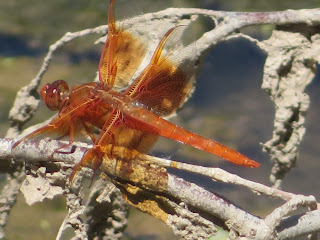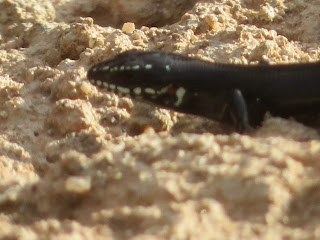
The warm, humid nights have brought out the competitive singing nature of the local field crickets. Usually they will hide if observed too closely, but this guy stayed chirping, this act is technically called stridulations
The sound of crickets can be maddeningly hard to locate, because those insects have to be careful not to attract the attention of the local big toad.There are not many of the large guys around. Actually, most of the toads listening right now are likely to be about the same size as the crickets! These are the young-of-year toads (YOY). How many survive has a big effect of numbers of crickets next year.
Even the tadpoles tend to be larger than the tiny toadlets. The tadpoles are really just designed to eat plant material, kind of like a amphibian version of a caterpillar.
Other insects are out hunting. The mantid species like this one are mostly in the tree canopy. They prefer smaller prey; like flies, that they catch during the daylight. By being stealthy they can catch many insects each day.
These colorful dragonfly prefer to leap out and snatch insects in between mid-flight wrestling competitions and dogfights.
The vast majority of the dragonflies out right now are in the genus king skimmer. They are the biggest and flashiest of the dragonflies and seem to be very much into territoriality.
The butterflies are mating and also puddling. Their behaviors are a lot more complicated than just fluttering about in a dance.
Most insects are a lot more complex than they would at first appear. These bagworms are involved in all sorts of strange behaviors, the majority of which have never been studied. It is always hard to say if that research is worthwhile, but most of the time spend studying animal behavior does produce useful insights. Sometimes in strange fields not really related.
The stormy weather has produced a few showers, which has a definite effect on behavior of all the bosque's inhabitants.
As the old, wet wood dries out, it will often crack. Sometimes new plants grow from the fallen branches, or the wood becomes a new ecosystem. Often everything just becomes mulch to wash into the ditch.
This hose is attached to a pump and connected to a stagnant pond in a horse paddock. The water being drained is literally liquid horse manure. Being pumped into YOUR water supply. The ditches of Corrales are not a cesspool, but it is not for the lack of trying by some people...
surface water run-off does enter our ditches, of course. Usually it is in the form of a fine red clay if there has been heavy rains. This lays down a thin, sticky film that preserves footprints perfectly. This shows a story to those who care to listen. Here is a pattern formed by an active squirrel trying to leap across without getting too dirty.
A garter snake left this trail as it hunted for tadpoles left in the tiny puddles. Snakes are uniquely designed not to sink in mud.
The long fingers of raccoons also are ideal to find tadpoles buried in the soft mud. They often have more trouble walking around, but they definitely put in the miles as they patrol the ditches for signs of small things that wriggle.
I think this pattern is from a crayfish, but it could also be a lizard. I'm not too sure, but have plenty of time to find more tracks.
These inward pointing feet are from a toad. A pretty small one, that was half swimming at this point. I rarely find their eggs, but those toadlets are everywhere.
The turtles are pretty easy to spot as they hunt around in the last of the water in the ditch. They feed and nest in these patches of water. That are disappearing quickly this year.
While this red eared slider is invasive, no-one wants to see it squashed by a truck. This one was moved to the road in the direction it was facing.
The day has to be pretty sunny to entice these whiptails out of hiding. They are feeding very well right now.
The fence lizards also are enjoying the bright sunlight on the rough bark of the older cottonwood trees.
New to the herpetology line up are these juvenile skinks. The are dark colored, with bright blue tails. They grow into large, brown, sleek lizards with tiny legs.They move very differently from the other lizards however.






















No comments:
Post a Comment